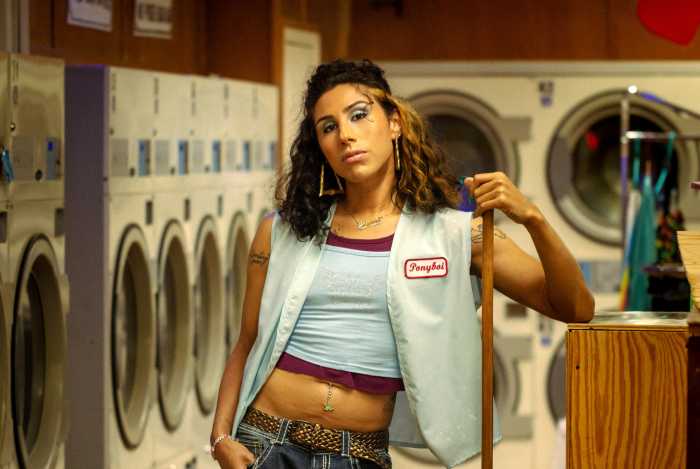‘60s radicalism viewed more credulously in Swedish doc than by US mainstream media
Late in “The Black Power Mixtape 1967-1975,” singer Eyrkah Badu says that African-Americans have to tell their own stories. Otherwise, as she points out, “[we’ll] get our noses blown off.” Survivors of Paul Haggis’ “Crash” will know exactly what she means. Ironically, however, he’s saying it in a film made by a white Swedish director.
“The Black Power Mixtape 1967-1975” resurrects news footage shot by Swedish TV journalists, some of whom appear on camera. The Swedes have a genuine curiosity about American politics and culture. They also have a distance from it that allows them to show more overt sympathy toward the Black Panthers and Angela Davis than the American media does.
Goran Hugo Olsson’s documentary combines the period footage with audio commentary from a wide range of activists, including Davis, as well as singers and musicians influenced by the Black Power movement. “The Black Power Mixtape 1967-1975” is sometimes scattershot but more often fascinating.
The press kit of “The Black Power Mixtape 1967-1975” comes with an extensive timeline of the civil rights movement, stretching back to 1955. The film devotes relatively little time to Malcolm X, relegated to two sound bites, and Martin Luther King. While some of the early interview subjects discuss King, the film quickly moves on to more radical activists like Stokely Carmichael.
Rapper Talib Kweli defends King’s non-violent tactics, but argues that they wouldn’t have been as effective without Carmichael. Badu (in a present-day interview) and Davis (in 1972) defend African-Americans’ right to self-defense, via guns if necessary, but a case could be made that the Black Panthers’ brandishing of guns played into white stereotypes. The film doesn’t make that case –– for better or worse, it’s entirely uncritical of its subjects.
By calling his film a mixtape, Olsson doesn’t mean that it contains wall-to-wall music. For a film filled with interviews with musicians (ranging from Harry Belafonte to Roots drummer Aamir “Questlove” Thompson, who also composed the score), “The Black Power Mixtape 1967-1975” actually uses only four songs, although they’re played back repeatedly. Soul and funk music of the period spoke eloquently about the aspirations embodied by groups like the Black Panthers, but Olsson assumes that his audience would know that.
The territory covered by “The Black Power Mixtape 1967-1975” is relatively fresh, especially for viewers who didn’t live through the period. The film’s perspective sometimes appears odd; it takes angles no American film would. For example, it devotes several minutes to a Swedish TV broadcast about a TV Guide article attacking Swedish TV as anti-American, including an interview with radical American documentarian Emile de Antonio. The connection to Black Power here is only implicit.
At the same time, the film follows a trajectory familiar to many accounts of ‘60s radicalism –– initial euphoria and a sense that anything is possible followed by a lengthy, painful comedown. Even European films about white radicals –– like Rainer Werner Fassbinder’s “The Third Generation” and Claude Chabrol’s “Nada” –– emphasize the painful death of the dream that changing the world could be easy.
“The Black Power Mixtape 1967-1975” doesn’t dwell on the FBI’s efforts to destroy the Black Panthers –– it devotes far more time to the government’s case against Angela Davis –– but J. Edgar Hoover insured that their appeal would be limited and their leaders dead or locked up. Who knows what they could have accomplished without such repression?
“The Black Power Mixtape 1967-1975” culminates in a lengthy look at the effects of heroin on the African-American community and Louis Farrakhan’s depoliticized brand of activism centered around altering oneself rather than the world.
Olsson’s film closes with some of its interview subjects offering their thoughts on the lingering significance of the Black Power movement. One of the cutting ironies of history, however, remains off-screen. The far left in America remains marginalized, while the Tea Party has taken up the mantle of revolutionary rhetoric and hostility toward the government (with far less justification) that the Black Panthers once used. No doubt most in the Tea Party detested the Black Power movement back in the ‘60s and ‘70s, but that hasn’t stopped them from co-opting its style.
At the same time, no matter how many times Barack Obama proves his centrist bona fides, some far-right pundits persist in acting as if he’s the second coming of Stokely Carmichael. Black Power may have been deliberately erased from American history, but its influence has persisted in some strange forms.
Essentials:
THE BLACK POWER MIXTAPE
1967-1975
Directed by Goran Hugo Olsson
Sundance Selects
In English and Swedish with English subtitles
Opens Sep. 9
IFC Center
323 Sixth Ave. at W. Third St.
Lincoln Plaza
1886 Broadway at W. 63rd St.


































